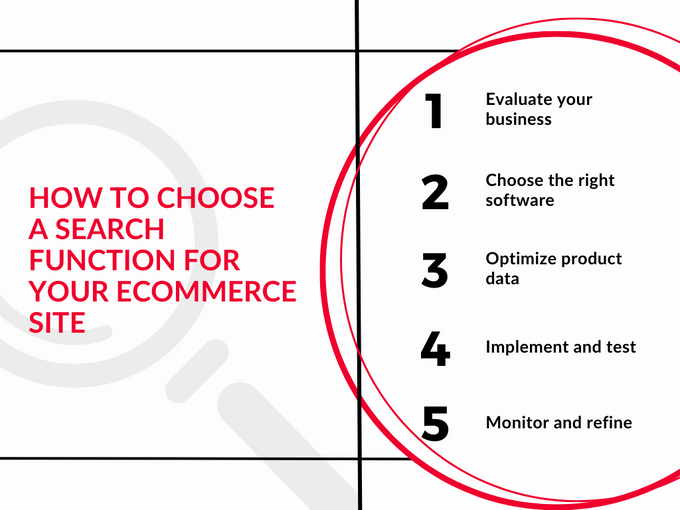How to Choose a Search Function for Your Website: 5 Considerations
Enhance your eCommerce site experience with an on-site search engine and AI
Updated November 19, 2024.

Enhancing your eCommerce site with a practical search function is a crucial step for improved user experience. A correctly implemented search function can increase search success, resulting in more conversions. For example, one of our clients, Satya Jewelry, significantly improved their conversion rates after adding a site search function to their site.
Let's investigate five fundamental steps for adding a search function to your site, and the ways you can optimize and enhance it to improve user experience.
Meet the Expert
Jameela Ghann has over 10 years of eCommerce experience. She runs a successful online store, Alora Boutique, and is the marketing manager for Fera Product Reviews.
1. Evaluate Your Business Needs
Begin by assessing your specific business requirements and identifying any gaps in your website's functionality. Consider how adding a search function will enhance the overall customer experience.
When looking for the right search function for your website, you must ensure it will be compatible with your website content and size. Analyze key factors, such as:
- Your product catalog size
- The complexity of your product data
- Website traffic volume
These factors will help you determine the specific requirements for your search function.
2. Choose the Right Software
Select a search software solution that aligns with the needs and requirements you outlined during the evaluation stage. For larger product catalogs, we recommend opting for a robust solution that can effectively index and manage your inventory.
Consider search software tools with AI-powered features for advanced search capabilities. Ensure it's compatible with your existing apps and features, such as product reviews, to maintain a seamless user experience.
» Not using AI yet? Discover how AI can benefit your eCommerce store
3. Optimize Product Data
Before implementing the search function, ensure your product data is well-structured, detailed, and includes relevant keywords. High-quality product data is essential for improving the accuracy of search results. Including a wide range of relevant keywords will help customers find what they're looking for, even when they aren't sure how to phrase the query.
» Explore natural language search to make sure you speak your customers' language
4. Implement and Test
Implement the chosen search software on your website, preferably in a test or development environment, especially for larger eCommerce stores. Place the search bar prominently at the top of your web pages to maximize visibility.
Consider using A/B testing to help you choose the best placement for the search bar. You can also leverage this method to test your search function's capability for the different eCommerce search query types, or to test out two different search functions.
5. Monitor, and Refine
Continuously monitor the search function's performance and pay attention to the search queries customers use. Performing a regular audit will help to improve search functionality, which in turn will result in a better conversion rate.
Refine your product categorization and search settings to improve accuracy and user satisfaction. Pay attention to customers who don't convert after using the search function. Why did they leave the page? Is there something you can change or improve to secure a conversion in the future?
These fundamental steps provide a solid foundation for integrating an on-site search engine function into your eCommerce website. While there are additional advanced strategies you can explore, following these essential guidelines will ensure that your site's search functionality meets your customers' needs and enhances their shopping experience.
Optimizing the Search Bar's User Interface and Design to Enhance User Experience
Simplicity is key when optimizing the user interface and design of your eCommerce website's search bar. Here are some best practices to enhance the user experience:
- Placement at the top: Position the search bar at the top of your webpage where users expect to find it. Avoid the urge to be overly creative—familiarity is crucial.
- Clear icons: Use a clear and universally recognized magnifying glass icon to signify the search function.
- Size matters: Ensure the search bar is large enough to be easily visible and interactive. Take inspiration from successful examples like Crate and Barrel's search bar placement.
- Basic filters and sorting: If you're a new store, start with broad filter options like relevance and price (low to high).
- Autocomplete and suggestions: Invest in an app that offers autocomplete and suggestions, as these features enhance the search experience for your users.
Leveraging AI to Enhance Your Search Functionality
AI offers valuable capabilities to enhance site search functionality, improving the overall user experience. Here are some ways AI can be a game-changer for your eCommerce navigation:
- Personalization AI enables personalization by allowing users to sort search results by best-selling or highest-rated products. It can also provide personalized recommendations based on users' past behavior, enhancing user engagement and satisfaction.
- Semantic understanding Machine learning algorithms integrated into AI can comprehend the meaning behind search queries. This understanding leads to more relevant search results, ensuring that users find what they're looking for quickly.
- Autocomplete and predictive search AI-driven autocomplete features predict user queries and provide real-time suggestions, significantly improving the speed and accuracy of search results. This feature streamlines the search process and keeps users engaged.
- Trend identification AI tools can identify trends in your product offerings, allowing you to highlight trending items prominently in search results. This is especially useful when your products gain popularity due to factors like social media trends or viral content.
Future-Proofing Your eCommerce Search Functionality
Enhancing your eCommerce site with a well-implemented search function is pivotal for maximizing sales through an improved user experience. By following the guide above you can build a robust on-site search engine.
Optimizing the search bar's design with simplicity in mind and leveraging AI technology can further elevate user satisfaction and conversion rates. These steps lay the foundation for a user-friendly and efficient eCommerce search function, ensuring your website meets customers' needs and enhances their shopping experience.
» Get the best Magento Search and BigCommerce Search capabilities for your eCommerce store





